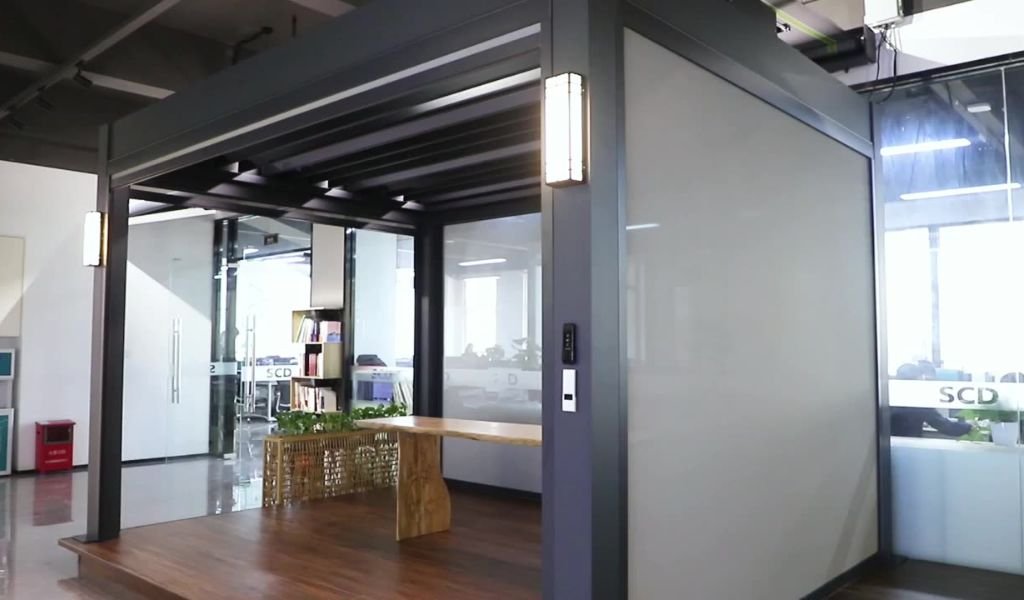Which Material is Best for Outdoor Blinds?
Outdoor blinds are a great addition to any outdoor area since they offer privacy, shade, and weather protection. But picking the right material for your outdoor blinds might be challenging. Consideration includes factors like robustness, resistance to external elements, need for care, and aesthetic appeal. In this article by Design Furniture, we’ll examine the qualities of various materials frequently used for outdoor blinds so you can make an informed choice based on your requirements and tastes.

1. Polyvinyl Chloride Blind
PVC is a preferred material for outdoor blinds Dubai, because of its durability and cost-effectiveness. PVC blinds are appropriate for prolonged outdoor use since they are resistant to moisture, sunshine, and extreme weather. You can choose the ideal option for your outdoor decor because they come in a variety of colors, patterns, and textures. PVC blinds only require occasional washing with mild soap and water in terms of upkeep. They might not provide as much insulation as other materials though. Exposure to sunlight over an extended period might lead them to fade or become brittle.
2. Bamboo Blinds
For outdoor settings. Bamboo blinds offer a natural and environmentally beneficial choice. They provide privacy and sun protection while fostering a cozy atmosphere. Bamboo is a sustainable material that can be used outside because it is UV-resistant. Bamboo has built-in insulation that naturally controls temperature and minimizes heat transfer. However, compared to other materials, bamboo blinds could need more upkeep. To avoid mildew or moisture damage, they occasionally need to be resealed and require routine cleaning. Although it is resilient, if exposed to extreme weather conditions regularly, it can progressively fade or decay.
3. Canvas Blinds
Canvas is a traditional material for outdoor blinds because of its strength and adaptability. In addition to offering great defense against elements like rain, wind, and sun damage, it also has a classic timeless appearance. You can personalize your outdoor space by choosing from a range of colors and designs for your canvas blinds. To increase their weather resilience, they are frequently coated with UV inhibitors and waterproof coatings. To preserve their performance, canvas blinds need to be cleaned frequently, and waterproofing chemicals reapplied occasionally. Although canvas is a sturdy material, constant exposure to the elements can cause it to degrade.
4. Polyester Blinds
Blinds made of polyester strike a balance between toughness, usefulness, and beauty. They are suitable for outdoor use because they are UV and mildew resistant. Polystyrene blinds come in a huge selection of colors and designs, offering countless opportunities for customization. They are simple to clean and usually just need to be softly wiped with a moist cloth. Polyester is a tough material that won’t fade or rip and will provide long-lasting performance. However, polyester materials can build up static electricity in dry areas and could not offer as much insulation as some other materials.
5. Acrylic Blinds
A high-end solution for outdoor areas, acrylic blinds are renowned for their toughness and excellent performance qualities. They are ideal for prolonged outdoor usage because of their high UV resistance, waterproofing, and colorfastness. You can attain the necessary visual appeal with acrylic blinds because they are available in such a broad variety of colors, textures, and patterns. They require little maintenance which is washing with little soap and water. They will last a long time because acrylic is a durable material that can tolerate high temperatures and resist fading. However, compared to other materials, these blinds are more expensive and their superior quality might not be required for all outdoor applications.
6. Aluminum Blinds
Outdoor blinds are frequently made of aluminum since it is strong and lightweight. It provides exceptional corrosion and rust resistance, making it suitable for coastal regions or high-humidity zones. Because aluminum blinds come in a variety of colors and finishes, there are several design possibilities. They require little upkeep and are simple to clean with warm soapy water. Aluminum blinds offer excellent insulation, assisting in temperature control and minimizing heat transfer. Since light can flow through the slats, they could not offer as much privacy as other materials. Aluminum blinds might also be more expensive than certain other materials, but they are a wise investment due to their durability and resilience to the environment.
7. Wood Blinds
Outdoor settings benefit majorly from the warm, natural aesthetics that wood blinds provide. They offer privacy and sun protection while fostering a cozy atmosphere. Wood is a strong substance that can survive a range of weather conditions. To avoid moisture and UV deterioration, it needs routine maintenance. To increase the longevity of wood blinds, protective coatings and sealants must be applied. To match your outdoor decor, wooden blinds can be customized with various stains or paint colors. Wood is a lovely alternative, but because it can bend or rot over time, it may not be appropriate for locations with high humidity or heavy wetness. Wood blinds must be properly maintained and cleaned frequently to remain in top shape.
8. Woven Blinds
Outdoor spaces benefit from the unique texture and organic feel of woven blinds, which are frequently manufactured from materials like reeds, grasses, or natural fibers. They provide seclusion and sun protection while having a natural appearance. Woven blinds are ideal for outdoor use since they are extremely durable as well as UV-resistant. They produce a cozy and breezing atmosphere by letting air flow while blocking excessive sunlight. Contrarily, woven blinds may need more upkeep than blinds made of other materials. To avoid moisture damage and to keep them looking good, they require routine cleaning. These blinds have a certain aesthetic appeal, but they cannot be as effective as other types of blinds in terms of insulation or complete light blockage.
Conclusion
It’s critical to choose the proper material for your outdoor blinds to guarantee their longevity, practicality, and aesthetic appeal. Each material comes with advantages and important considerations. PVC blinds are inexpensive and waterproof, however, they might not be insulated. Although they need routine care, bamboo blinds offer a natural plus environmentally responsible solution. Canvas blinds provide a timeless appearance and trustworthy weather protection, but they also require routine maintenance. Polyester blinds may lack insulation but are durable and simple to maintain. Acrylic blinds are a high-end option with exceptional performance qualities, but they are more expensive. While wood blinds create warm, natural aesthetics, aluminum blinds are durable and more corrosion-resistance. Take your unique needs and preferences into account to make an informed choice and improve your outdoor living spaces.




